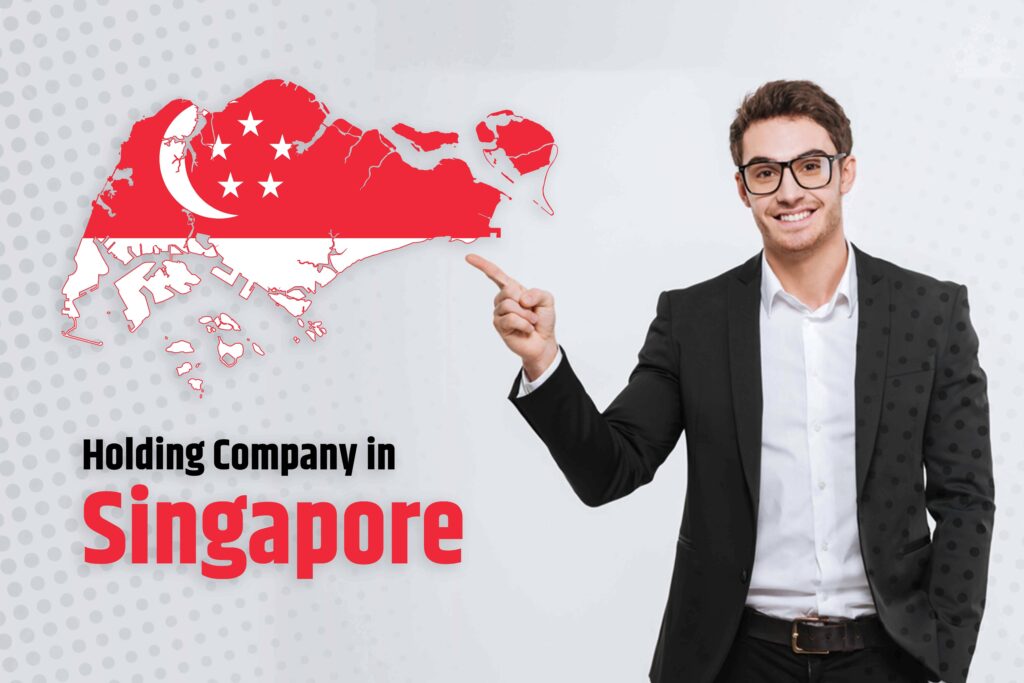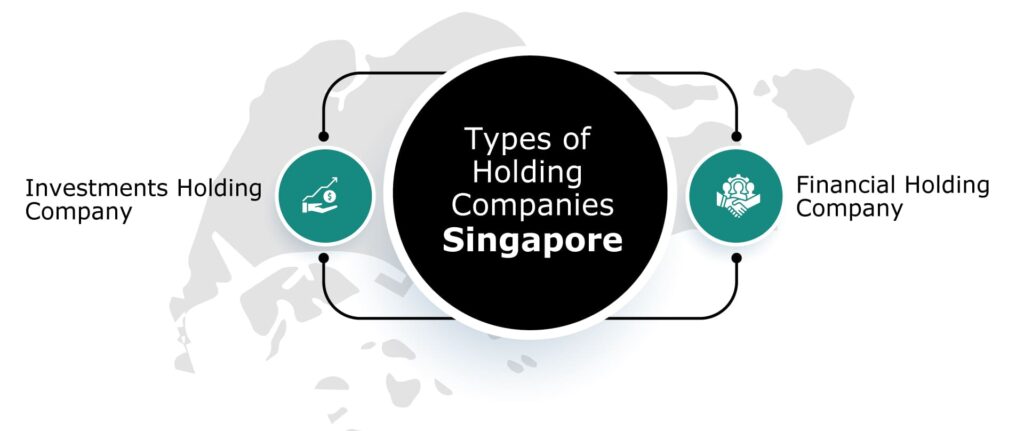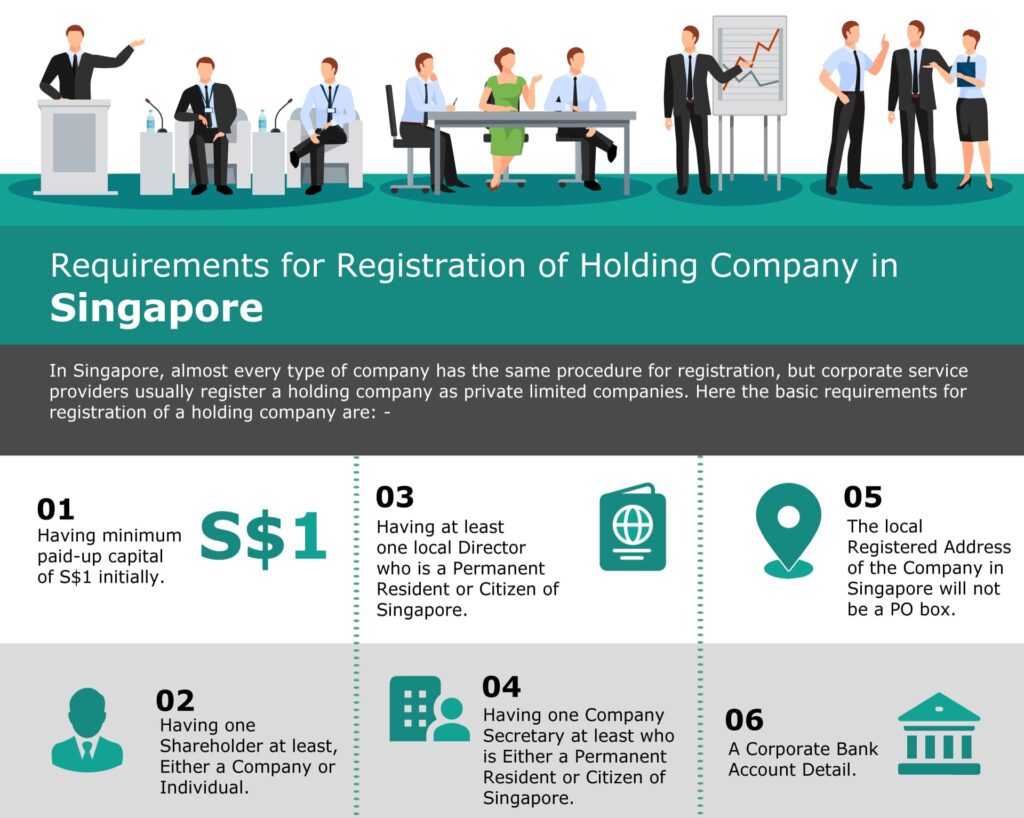
Singapore is a very business-friendly place. Many new investors choose Singapore to start their business. According to the World Bank report of 2016, Singapore was ranked as the world’s best country for conducting business. For seven consecutive years, it ranked as the number one country for its efficient and open economy amongst 82 countries by the economist intelligence unit (EIU).
Singapore is also awarded for its productive workforce by a US-based research group. And many more awards are received by Singapore for its business environment and facilities.
Here, we will discuss the procedure and benefits of setting up a holding company in Singapore.
What is a holding company?
A holding company is not like a normal company as it does not conduct its business operations and transactions on its own. It is controlled by another company which is its subsidiary company. It has some of its assets but not all the assets it owns. When a holding company is operated in Singapore, then it is a Singapore company, and it has its subsidiary company either in Singapore or outside Singapore.
Types of holding companies in Singapore

There are two types of holding companies that are operating in Singapore. They both have their registration criteria but almost the same taxation. These are: –
- Investments holding company
- Financial holding company
Requirements for registration of holding company in Singapore

In Singapore, almost every type of company has the same procedure for registration, but corporate service providers usually register a holding company as private limited companies. Here the basic requirements for registration of a holding company are: –
- Having minimum paid-up capital of S$1 initially.
- Having one shareholder at least, either a company or individual.
- Having at least one local director who is a permanent resident or citizen of Singapore.
- Having one company secretary at least who is either a permanent resident or citizen of Singapore.
- The local registered address of the company in Singapore will not be a PO box.
- A corporate bank account detail.
Registration procedure for holding companies
The process of registering a holding company in Singapore is very simple. It mainly involves only two steps. These are: –
- First, you have to get approval for the name of the company from ACRA.
- As the next step, once the name of the company is approved, then you need to apply through online mode by submitting all the requirements for the application.
You can apply through BizFile+, which is available on the ACRA portal. The registration process will take 3 working days to complete usually, but sometimes it may take a longer period. This only happens when ACRA is required to submit the registration application to other agencies for further verification.
What are the benefits of a holding company in Singapore?
Singapore is a country that is well known for its economy, and it also has an ideal location for trade. Also, it is one of the wealthiest countries currently. Its economical conditions and government policies make it easy to conduct business smoothly in Singapore.
A holding company can be very beneficial to set up in Singapore. Check out some of them below-
- Finance and risk reduction-
The structure of the holding companies reduces the risk of the overall failure of the whole company. This reduces the risk of the entire industry and also lowers the cost of capital.
Holding companies also acquire more finance for the industry in comparison to a single company structure.
They help their subsidiary companies to get finances for their projects easily by providing downstream guarantees to them. It also reduces the cost of capital of their subsidiary companies in Singapore.
These companies are designed to separate capital intensive for their subsidiary companies from operating subsidiary companies.
Since the subsidiary Companies are treated as limited liability companies in Singapore, they can start multiple risky business operations, and this will not affect the holding companies. Holding companies help in reducing their risks and arrange finance also. The liabilities of each company are treated as its liability, and you cannot spread to other parent or subsidiary companies.
Financial troubles of a subsidiary company then are limited to the company only. It will not impact holding companies or other subsidiary companies under that parent company. This will attract financial institutions and bankers so that they can arrange finance easily, and this also increases the trustworthiness of these companies.
- Tax benefits of Single-tier tax system-
In Singapore, there are very favourable tax policies for companies. A good understanding of the tax system will help you minimize your tax.
Single-tier corporate tax
There is only a one-time tax on the incomes of the Singaporean company. Dividends earned by shareholders from a Singaporean company will not be taxed in the hands of the shareholders.
At the moment, Singapore’s corporate tax rate is 17%. However, a holding company in Singapore gets many tax cut schemes in Singapore. So, this will lower the tax payable.
According to the partial exemption tax scheme, a holding company is entitled to have-
- Tax exemption of 75% on the first $10,000.
- And an additional exemption on the next $190,000 of 50%.
According to the following scheme, the tax rate on the first $10,000 will be 4.25% only, and on the next $190,000 will be 8.50% only. In addition, they can also get further tax rebates annually. And also, they are liable to get some expense deductions.
There is no tax on the capital gain on holding companies in Singapore and no withholding tax on dividends only when they pay dividends to resident and non-resident shareholders. This exemption is applied to foreign-based holding companies also.
- Foreign income tax and Double Tax Treaties System-
Foreign income tax
In Singapore, there is a tax on foreign income only if they are received in Singapore. In other words, locally received incomes are taxed only in the case of a holding company in Singapore. When a holding company in Singapore receives income from its foreign subsidiary company, then it will locally tax in Singapore.
But if a holding company follows the following criteria, then it will be exempted from the foreign-based income to be taxed. These criteria are-
- The income is already subject to tax in that foreign country.
- The foreign income tax rate of that company will be at least 15% of that foreign country at the time of income received in Singapore.
3. The local tax authority of Singapore is convinced that this is beneficial for residents’ taxes.
Double taxation treaties
Currently, Singapore has a double tax treaties network with more than 80 countries around the globe. These tax agreements result in a reduction in tax rates or tax exemption when the respective income is transferred to Singapore from the involved country.
When a holding company in Singapore receives income such as dividends, interest, and royalty from the foreign subsidiary company, which is located in the country which has tax treaties with Singapore, then it will result in lowering of its tax or exemption of tax. This has proved very beneficial for a holding company to have its subsidiary company in a country that has a treaty network with Singapore.
- Group relief-
A group relief system is a system that enables a company to transfer its losses to another company of the same group. These losses may be an unabsorbed capital allowance of the current year, unabsorbed trade losses of the current year, and unabsorbed donations of the current year.
By using this system, a subsidiary company transfers its losses of the current year to the holding company for absorption of these losses. It can be set off against the income of its holding company. The company which transfers its losses is called a transferor, and which receives the losses are known as claimant companies.
Certain conditions are required to be fulfilled before transferring losses from one company to another. These are-
- Both the companies that are transferor and claimant companies are Singapore-based companies.
- Both the companies belong to the same group and maintain 75% of the shareholding rate. That means one company holds at least 75% of the ordinary share capital of the other company of the group. Or a third-party Singapore-based company holds 75% of ordinary share capital in both companies.
3. Both companies must have the same financial year-end.
Conclusion
In this article, we saw what a holding company is and how does it factors in the international workspace with all the various organizations and businesses that run under supervision.
We went through all the necessary information one requires to understand a holding company, its different types, and the legal and institutional requirements that come into play before and after registering your holding company in Singapore.
Not only internationally, but we through the national process around a holding company in Singapore, benefits of running such a company, and complications that come along with it, including taxes, risks, etc.
Odint Consulting constantly works on providing all the legal and corporate services helpful in setting up and running a successful business in national and international markets.

